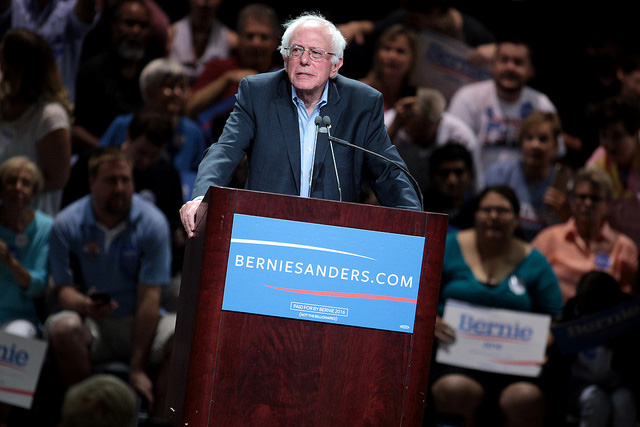
Bernie Sanders routed Hillary Clinton in three Western states on Saturday. He isn’t just winning; he’s winning with stunning percentages: Alaska 82-18; Hawaii 70-30; Washington 73-27. He’s taken five of six in the West, and chipped away Clinton’s lead in pledged delegates, trailing in pledged delegates by 1243 to 975.
The Clinton campaign, echoed by the talking heads, sought to discount the victories as “expected” from the “largely white and liberal” Pacific northwest. But just as Clinton’s victories in the South should not be dismissed because they were built on loyal African-American voters, Sanders’ victories shouldn’t be dismissed either. Liberals are Democrats, too.
Sanders remains an underdog, but he keeps surging and Clinton keeps sinking. Sanders has won 15 primaries and caucuses compared to Clinton’s 20, and he’s virtually tied four others (Iowa, Massachusetts, Missouri and Illinois). This from an unknown candidate who started at single digits in early polls. His crowds keep growing. The turnout in Washington was “huge,” state officials reported, nearly at the unprecedented levels of 2008. And he’s done this in spite of a mainstream media that can’t cover his campaign without dismissing it.
Sanders has now caught Clinton in the most recent poll of Democrats. He raised more money than she did in February (probably one reason the Clinton campaign didn’t blanche at sponsoring a $353,000-a-plate sit down with the Clooneys on April 15 in San Francisco. That number is not a misprint.)
What’s troublesome for Clinton is that she’s getting less popular as the campaign goes on. She’s now viewed unfavorably by over 50 percent of registered voters, the highest negatives — other than Donald Trump — since 1984 when they began asking the question. Voters have valued her experience and electability. But she’s had to walk away from many of her former views. And she continues to fare less well than Sanders in hypothetical face-offs with potential Republican candidates. Those polls are of questionable import, but they do suggest that electability may be a declining asset for the former secretary of state.
Even as his candidacy gains traction, Sanders keeps spreading the word and rousing activists. A presidential campaign isn’t a movement. At best, an insurgent can issue a call to action, elevate alternatives, and infuse millions with a sense that there is an alternative. Sanders is doing just that, particularly with young voters who fill his rallies and caucuses.
He’s raised a stunning $140 million from some 2 million donors, proving that a candidate needn’t depend on big money to be competitive. This is a big deal. Sanders has shown it can be done at the presidential level. Now, we’ll see insurgents testing out similar efforts in Senate and House races.
Sanders’ talented campaign team has learned how to benefit from activists that can and are organizing themselves, creating their own communities online and in neighborhoods. This is energy that will continue long after the campaign is over.
Clinton operatives suggest Sanders should cool it, and stop challenging the secretary. She is trying to avoid a debate before the New York primary. Sanders is well justified to turn up the heat. He’s driven the debate, with Clinton adopting increasingly populist positions. He’s now beginning to challenge Clinton’s hawkish foreign policy. His speech on the Middle East showed remarkable courage and sense. He ran a moving ad in Hawaii featuring Hawaii veteran, Rep. Tulsi Gabbard, former vice chair of the Democratic National Committee, arguing, “Bernie Sanders will defend our country and take the trillions of dollars that are spent on these interventionist, regime change, unnecessary wars and invest it here at home.”
Sanders still faces formidable challenges — including competing with Clinton in her home state of New York where she served as senator. But what’s clear is that he is still building. Wisconsin is next on April 5, with the Wyoming caucuses on the 9th. New York is on the 19th. Instead of continuing their 24/7 Trump fixation, the mainstream media would be well advised to cover the Sanders surge, not dismiss it, and put a bigger spotlight on the Democratic race.
Join us in defending the truth before it’s too late
The future of independent journalism is uncertain, and the consequences of losing it are too grave to ignore. To ensure Truthout remains safe, strong, and free, we need to raise $33,000 in the next 2 days. Every dollar raised goes directly toward the costs of producing news you can trust.
Please give what you can — because by supporting us with a tax-deductible donation, you’re not just preserving a source of news, you’re helping to safeguard what’s left of our democracy.